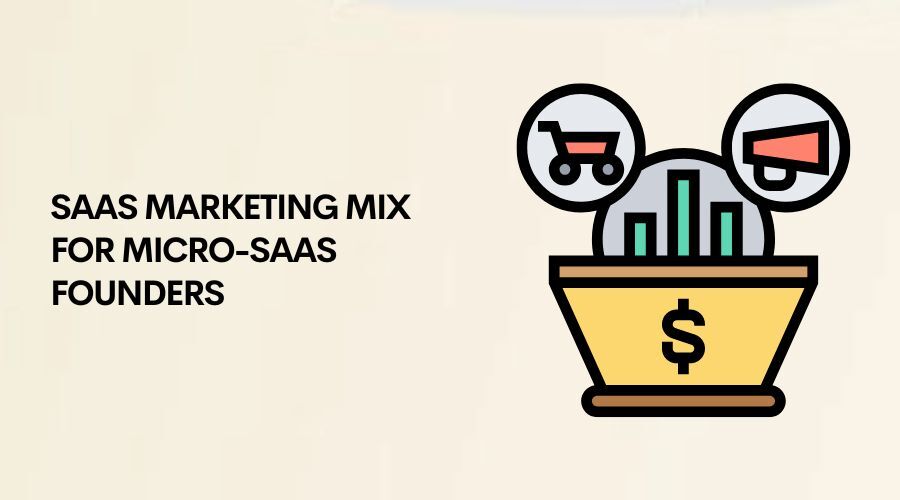Developing a micro-SaaS marketing mix is an integral part of your business plan.
Because—and let’s face it—nobody won’t buy your software if they don’t know it exists.
At the same time, marketing is more than just promoting your micro-SaaS product to your target audience.
There are other elements at play in your marketing mix that all help you attract paying subscribers and generate revenue.
This post discusses what you must include in your marketing mix and how to implement them correctly.
What Is a Micro-SaaS Marketing Mix?
The term “marketing mix” first surfaced in E. Jerome McCarthy’s book Basic Marketing: A Managerial Approach.
It comprises various tactics forming a cohesive strategy that gets your business in front of prospects and drives growth.
The book initially mentions four Ps and has now expanded to seven Ps.
But for the sake of brevity, we’ll stick to the first four.
They should be enough to provide micro-SaaS companies with a framework to develop and implement a scalable marketing strategy optimized for growth.
Watch the video below for a shorter explanation of what the 4Ps are.
How Should the 4Ps Work in Your Micro-SaaS Marketing Mix?
1. Product
At the very heart of your micro-SaaS marketing mix is your product.
By this, we mean that your product has to solve problems your target audience has.
More importantly, there must be a strong, consistent demand for your product in the market.
By meeting these requirements, you can penetrate the market effectively and make money off your micro-SaaS software.
Here’s how to make sure your software can address your prospective customers’ needs before even selling it:
1. Develop your buyer persona
Buyer persona refers to the profile of your ideal customers.
What do they look like? What do they like and dislike?
Here, it would help if you break down your buyer persona into demographic and psychographic details.
Demographics refers to statistical characteristics that define the majority of your target audience. This includes things like age, gender, education level, and location.
On the other hand, the latter deals with the characteristics and traits your target audience has. Factors here can include their goals, values, fears, and dreams.
To build your buyer persona, you can start with your existing customers.
Find out who they are by looking at their online profiles and compiling their information.
This should give you an idea of the types of customers that find your SaaS or micro-SaaS valuable.
You can use a CRM tool like Hubspot CRM to help you collect and organize the information you’ll find.
You can also track their behavior on your website to see which pages they visit the most and how they engage on each page.
Observe what they commonly do, and you should be able to get an idea of who your buyer persona is.
If you don’t have customers yet, Hubspot’s Make My Persona enables you to create a buyer persona from scratch.
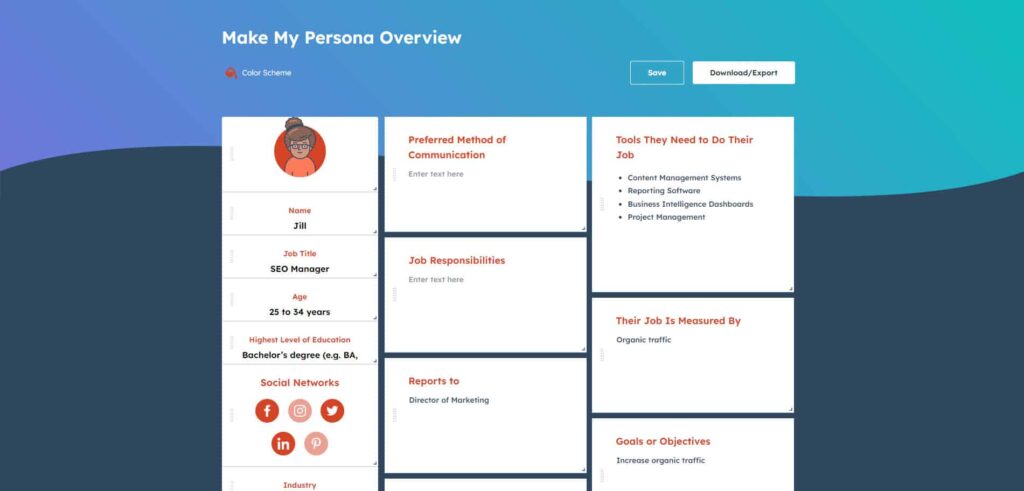
Simply fill out the form that best describes your prospect.
Once you’re done, you can edit the profile details and appearance before downloading it.
It’s also possible to have more than one buyer persona, depending on the use cases of your software.
Symalite Labs, for example, caters to first-time micro-SaaS founders and serial entrepreneurs.
We also target individuals who have earned a living in the past as software developer employees and now want to build something for themselves.
So if you serve multiple buyer personas, feel free to create as many of them as possible.
This way, you can target the right segments with your marketing campaigns.
2. Identify your value proposition
Once you have your buyer persona, you’ll want to create a simple statement that communicates your product’s benefits.
What makes your software better than other similar products in the market?
If it sounds difficult, refer to your buyer persona and notice how your software solves the pain points your target users experience.
The information you’ll gather should make your product’s benefits evident in its features.
To help you craft a one-sentence statement that best describes your competitive advantage, Peter Thomson’s value proposition canvas might be a good resource.
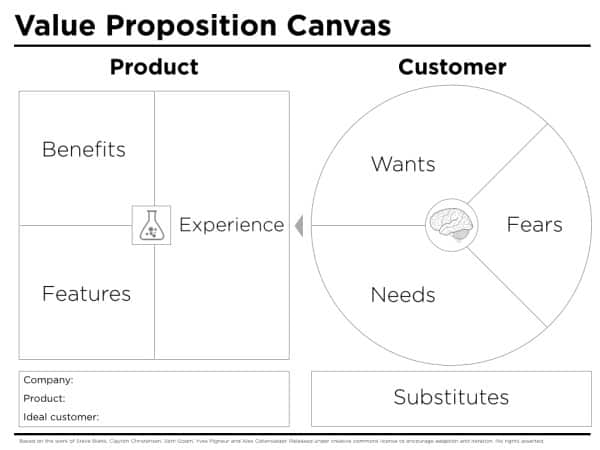
The framework identifies the variables that help contribute to a strong value proposition.
Take Chatsilo, for example. Its value proposition is about helping online entrepreneurs never lose a Messenger sale again.
Using the canvas above, here’s how we came up with its tagline:
Product
- Benefit: It takes away the pain of mismanaging potential and existing customers on Facebook Messenger.
- Feature: It contains project management tools that help you nurture your Messenger leads, manage chats, and follow up with prospects.
- Experience: It’s a mini-Facebook Messenger customer relationship management that lets you organize your Messenger conversations.
Customer
- Want: They want a better way to manage their conversations with prospective and existing customers on Facebook Messenger.
- Need: They need an affordable tool that provides all the features they need to get more sales via Messenger.
- Feature: The tool that will help them is one that lets them create Messenger sales funnels in minutes so they can organize their customer conversations on the platform.
Doesn’t sound that difficult anymore, does it?
It’s vital, therefore, that you answer all these variables to get a full view of your product and customer.
This will help you craft a suitable value proposition for your micro-SaaS software as Chatsilo did.
2. Price
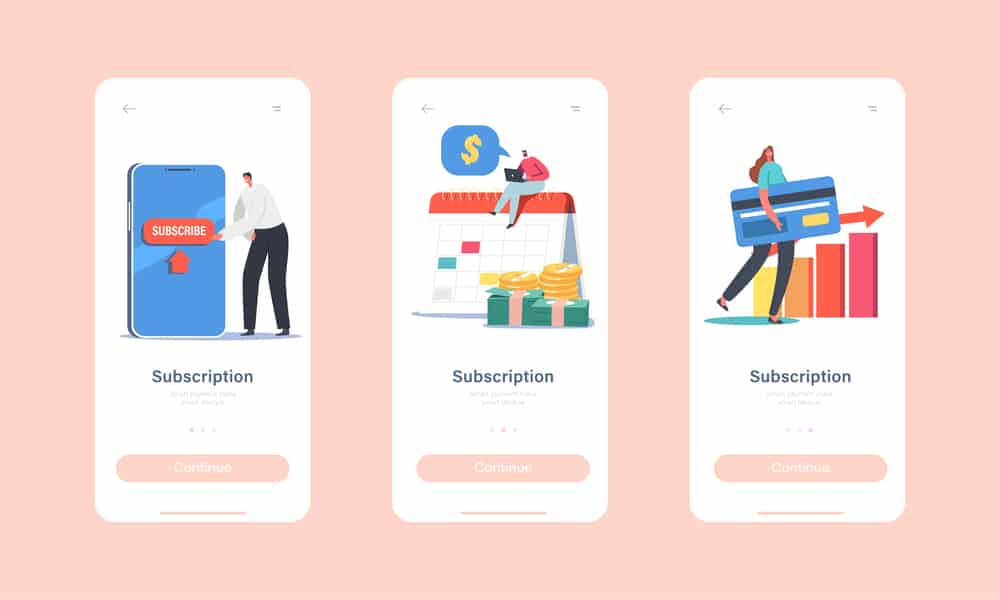
As part of the marketing mix, your pricing strategy determines how many will buy your product.
You don’t want to price your products too low such that you’re not earning enough from each sale or subscription.
At the same time, you don’t want to price them too high either, such that no one would even want to give your software a chance.
Thus, striking a balance between both pricing ranges helps you come up with the most appropriate price for your micro-SaaS software.
Below are ways you can do this:
1. Connect your buyer persona to their demands
If you have multiple buyer personas, be aware of the different features each of them needs from your software.
The goal is to create plans for your product that will each contain features relevant to a specific persona.
To do this, you need to ask your target audience about the features they need from your subscription plans.
If you have a direct way of contacting them, like an email list or messenger, send a Google Form survey where you can ask them this question and more.
Make the survey easy to complete by asking multiple-choice instead of open-ended questions.
This will help you increase the response rate, giving you data to back up your plans.
While you may want to appease prospective customers by including as many features as possible, you also need to consider the costs.
For instance, you can’t add premium features that cost a lot of money on basic plans.
You want to align your subscription plans with your prospect’s purchasing power, which we’ll get into shortly.
Once you have the information, you can piece together the pricing tiers for your software.
Meanwhile, for those with a single buyer persona, you may not need multiple paid plans for your software.
Instead, focus on developing a single paid subscription that satisfies most potential customers based on their survey responses.
2. Create pricing strategies
Once you have mapped the tier plans for your buyer personas, it’s time to plot out the prices for each.
You can utilize many strategies and examples to determine your product prices.
The most common approach in micro-SaaS is competitor-based pricing.
Here, you want people to see your software as more than a viable option over competing products.
In this case, use your top competitors’ prices as benchmarks to position your micro-SaaS product at a much lower price.
For example, LinkedIn automation tool Dux-Soup has Individual, Team, and Agency plans to choose from.
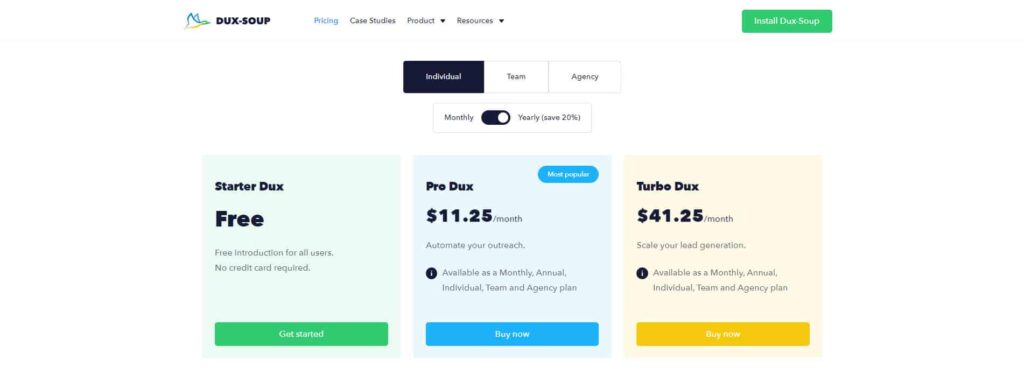
Compare this with Sales Navigator, LinkedIn’s premium sales tool that costs $79.99/month if billed annually.
Clearly, Dux-Soup positions itself as a more affordable option for people to conduct sales outreach on LinkedIn.
Its pricing tiers also show how the company aligns its respective features with its buyer personas.
The tool caters to individuals running a sales campaign on the platform (Individual plans) and teams looking to scale their outreach (Team plans).
Using the competitor-based strategy, you can penetrate the market more easily due to your lower prices.
In addition, you can attract initial subscribers to help get your micro-SaaS off the ground.
3. Determine your KPIs and metrics

When developing your pricing strategy, be sure to have a plan for measuring its success.
Key performance indicators (KPIs) help you with this, as they give you an overview of your micro-SaaS’ business health.
Sales and revenue are usually the KPIs you must monitor to track your pricing strategy.
After all, how much you earn over time from your product tells you a lot.
Still, it doesn’t tell you everything you need to know.
And that’s where micro-SaaS metrics come in.
Unlike KPIs, your metrics measure the performance of your business on a granular level.
For example, how many new subscribers do you generate every month? What are your churn and retention rates? Which pricing plans do they subscribe to? What role does total revenue play in your pricing strategy?
It’s best to monitor multiple KPIs together since they might affect each other.
For example, suppose your sales and revenue are increasing, but your subscribers remain the same.
This may be because your customers have upgraded to a higher tier.
On the other hand, if the number of your subscribers increased, but your revenue decreased, it’s possible that more customers are signing up for your basic plans while your maintenance costs are rising.
4. Change membership costs over time
As you implement your pricing strategy, try to maximize your revenue over time.
You can do this by increasing your basic plan’s price, decreasing the prices of your higher plans, or adding more features.
At the same time, having high sales shouldn’t stop you from boosting your revenue even more.
Look at the metrics you can improve.
For example, with customer engagement, you can create tooltips to educate customers on how to use your product features correctly.
Meanwhile, increasing your average revenue per account may include coming up with upsells and cross-sells to provide more value to your customers.
Much of your decision to change product prices should hinge on the metrics you have analyzed beforehand.
To make the job much easier for you, use a price optimization tool like Pricefx.
It automates the process of identifying valuable sales insights and opportunities.
From here, you can take action and get the most out of your price points.
3. Place

Finding where your audience is online is another step toward ensuring your micro-SaaS marketing strategy success.
While many gurus would recommend marketing your business on all online channels, it can be inefficient.
This is especially true for micro-SaaS entrepreneurs who don’t have the resources to cover all grounds.
The more helpful step would be to determine the channels where most of your prospective customers are.
This way, you can focus your energies on reaching them for higher conversions.
Here’s what we suggest:
1. Competitor research
This step requires taking a cue from your competitors on where they get most of their prospects from.
Doing this lets you reverse-engineer their campaigns and see what’s working for them. This way, you can also replicate their strategies.
A tool like Spyfu comes in handy for situations like this.
Using the software, you can type in your competitor’s website on the search bar to find out how much traffic they get from organic and paid ads.
High organic and paid traffic means your competitor has very good SEO and ad strategies, respectively.
2. Social listening
To verify if social media is a channel you should prioritize in your marketing strategy, try to monitor keywords and terms relevant to your micro-SaaS.
See how many people are talking about each phrase on various social platforms and where their respective sentiments are.
If there are many posts on a specific social channel, consider developing a marketing campaign for each media.
You can do this using a tool like Mention.
Simply enter the keywords you want to track, and the platform will automatically find posts containing your search terms.
An example of a keyword you should monitor is your competitors’ brand names.
You can also monitor generic terms like “facebook outreach” for Group Leads, for instance.
After collecting the posts, check how many of them are positive and negative.
This will help you determine how to reach people on these specific channels with your micro-SaaS product.
If you find negative posts about your competitors, you can use this as an opportunity to promote your brand as a better alternative.
3. Google Analytics
If you have a website, use Google Analytics to check how many people are visiting it and which pages they’re browsing.
This free tool not only shows you which pages people have visited the most over time but also where they came from.
On the Traffic Acquisition page, you can see how many people come to your page in the following ways:
- Organic search (i.e., traffic coming from search engines)
- Direct (i.e., users typed in the site’s URL to visit it)
- Referral (i.e., visitors clicked on a link from another website to visit your page)
- Organic social (i.e., traffic coming from social media)
- Unassigned (i.e., Google Analytics cannot determine how the visitor got into your site)
You can even break down which specific source or medium you received the traffic from.
Click on the “session default channel group” to open a drop-down menu and click “session source/medium.”
Find which search engine or social media referred the most visitors to your website.
Make sure to focus on these channels when launching your upcoming marketing campaign.
To view data on your Google Analytics account, you must install the tracking code on your site immediately after setting it up.
This allows Google Analytics to collect all the historical data and see how you get website traffic over time.
4. Promotion

Now, the fun starts!
In this last “P” of your marketing mix, you must develop and implement SaaS marketing strategies to promote your micro-SaaS channels.
Below are the different ways you can promote on various online channels.
Bear in mind, however, that you should only focus on channels where most of your target audience is so you can maximize your campaign results and meet your KPIs.
1. SEO
Most people today use search engines to find your competitors.
It’s crucial, therefore, that you also optimize your website to appear on top of search results.
It all starts with keyword research. Find related keywords that lots of people search for.
Next, create pages to optimize for each keyword group. Also, develop and roll out a content marketing strategy by writing blog posts about your software.
Finally, launch a link building campaign to increase your site’s authority and its search rankings as a result.
Note that SEO takes around four to 12 months on average before you see its results.
This is because Google search spiders must crawl and index your pages.
The process takes a long time as a result of the millions of pages they have to process daily.
But if you do this correctly, you can generate a steady stream of highly qualified traffic even while you sleep.
2. Social media
The bulk of your social media marketing strategy should consist of publishing posts that engage your prospects.
For this reason, we generally recommend talking about your product and sharing tips on your topics relevant to your software.
Balancing both content types enables you to establish yourself as an authority on the topics and promote your micro-SaaS simultaneously.
If you’re managing multiple social media accounts, use a tool like Agorapulse.
It lets you view all your social profiles in a single dashboard for increased productivity.
You can also schedule posts in advance on your accounts so you can focus on monitoring their progress in the coming days.
3. Email marketing

With email marketing, the first thing to do here is to build an email list.
Start by creating an opt-in form for each stage in your sales funnel that prospects can sign up for so they can receive exclusive content from you.
To increase conversion rates of your forms, use lead magnets that address the pain points of your audience.
This can be in the form of checklists, cheat sheets, and templates that they can only get their hands on if they sign up.
Once they’re in your email list, create drip campaigns for each segment.
You can also send informative emails with advice about your topics of expertise for subscribers in the awareness stage.
Also, introduce how your product can help them solve their problems.
For those in the decision stage of your sales funnel, you can also create emails comparing your product with competitors and explain why they should use your software instead of the others’.
One of the best tools that let you collect email addresses and send emails to them are Drip and ConvertKit. Read our post to help you decide which is the best tool for you.
4. Paid ads
Unlike SEO, paid advertising generates immediate results from the start.
But while paid ads are more straightforward, running a campaign can get expensive.
Not only that, but if you don’t create your ads properly, you won’t generate the customers you want, which can result in a negative ROI.
5. Affiliate marketing

This promotional tactic enables people to promote your micro-SaaS on your behalf.
Upon signing up as your affiliate, they will receive a unique link to your product.
They can then get prospects to sign up for a paid subscription to your software by sharing their link creatively.
For every successful sale, the people who successfully refer a customer using your link will earn some revenue.
It’s a lucrative business model that lets you tap into SaaS marketers to spread the word about your micro-SaaS business.
To do this, you must first set up your affiliate program using a tool like FirstPromoter.
It lets you accept members to your affiliate marketing program and monitor how many customers each of them has referred to your business.
The platform also lets you know how much you owe them to send the payouts on time.
6. Demo webinars and events where your target users are

Webinars allow you to engage with your audience online and in real-time.
To make this happen, you need to choose a topic to discuss in your webinar.
It’s usually about a problem your audience wants to solve with the help of your micro-SaaS.
Next, set up a page where people can confirm their attendance for the webinar.
Afterwards, invite them to join your webinar via email or social media.
Platforms like Demio allow you to do all the above, from creating a landing page to holding the webinar.
Apart from webinars, you can also do face-to-face events and masterminds to build a more personal connection with your micro-SaaS audience.
Frequently Asked Questions About Micro-SaaS Marketing Mix
What makes micro-SaaS marketing different?
Micro-SaaS marketing lets you promote your digital product on a smaller scale. Since your software addresses a niche demand and is geared toward a specific audience, your marketing efforts are more concentrated and precise.
How does customer service play a role in micro-SaaS marketing success?
The work doesn’t end with converting people into paying customers. In fact, you need to keep them as your subscribers for as long as you possibly can. To this end, ensuring a great customer experience for your subscribers can help sustain—if not continuously grow—your monthly revenue.
Final Thoughts on Building a Successful Micro-SaaS Marketing Mix
Approaching your micro-SaaS marketing mix through the steps above is one of the ways you can successfully attract more subscribers to your software.
However, getting everything right in your marketing mix is easier said than done. In this case, Symalite Labs can help.
We help software founders develop and launch a marketing plan that will help them grow their SaaS businesses.
Click here to learn more about us.

